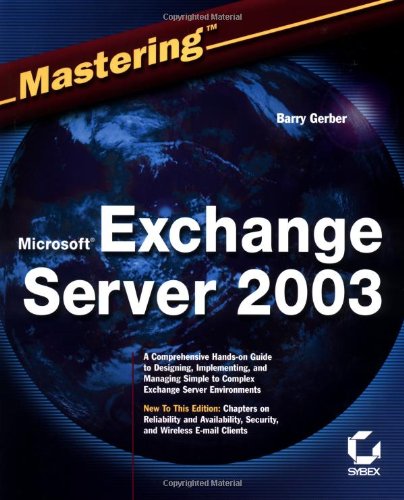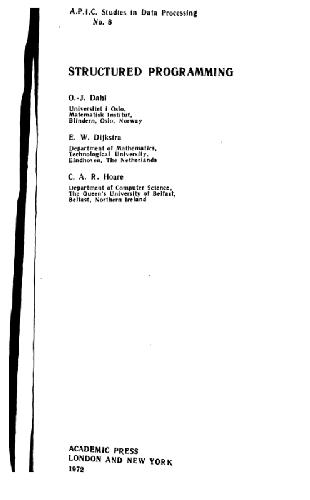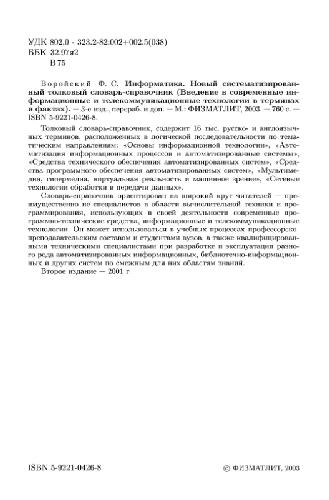Barry Gerber0782142044, 9780782142044, 9780585488172
Table of contents :
Mastering Microsoft Exchange Server 2003……Page 12
Table of Contents……Page 2
Overview……Page 15
Part I: Understanding and Planning……Page 17
Part III: The Outlook Client……Page 18
Part VI: Exchange and Outlook: The Next Level……Page 19
Conventions Used in This Book……Page 20
Part 1: Understanding and Planning……Page 21
Overview……Page 22
Why Microsoft Released Windows 2003 and Exchange 2003……Page 23
Exchange Server 2003 Applications……Page 24
E-Mail Is Only the Beginning……Page 25
Off-the-Shelf Messaging-Enabled Applications……Page 27
Objects……Page 28
Applications Using Exchange Public Folders……Page 29
Electronic Forms……Page 30
Exchange Server 2003 as a Client/Server System……Page 31
A Quick Take on the Outlook Client……Page 34
Exchange Server 2003’s Object Orientation……Page 36
Exchange Server 2003 Scalability……Page 37
Exchange Server 2003 and Other Electronic Messaging Systems……Page 38
Third-Party Applications for Exchange Server 2003……Page 39
Summary……Page 40
Overview……Page 41
Key Features of Windows Server 2003……Page 42
Active Directory, Security, and Internet Protocols……Page 43
What Hasn’t Changed in Windows Server 2003?……Page 48
Windows Server 2003 Versus NT 4 Server……Page 49
The Four Flavors of Windows Server 2003……Page 50
Exchange Server 2003 Features……Page 51
Bye-Bye, Exchange Directory Services……Page 52
Bye-Bye, Exchange Server Sites……Page 54
‘New’ User Interfaces……Page 55
Storage Groups……Page 56
Exchange Server 2003 versus Exchange Server 5.5……Page 57
Getting a Handle on Exchange Server 2003 Versions……Page 58
End-User Support Is Easy……Page 59
Summary……Page 60
What You Need to Know about Active Directory Right Now……Page 62
Active Directory: Five Major Architectural Components……Page 63
Active Directory Is Real Stuff……Page 67
Understanding NetBIOS, NetBEUI, and WINS……Page 68
An Alternative: Using DNS and DHCP……Page 69
Summary……Page 70
Key Exchange Server 2003 Organizing Components……Page 72
Information Store……Page 77
The Routing Engine……Page 79
Optional Exchange Server 2003 Components……Page 80
The Directory Synchronization Agent……Page 81
Exchange Internet Protocol Access Components……Page 82
Exchange Connectors……Page 83
Clients for Exchange……Page 85
POP3 and IMAP4 Clients……Page 86
Summary……Page 87
Taking the Large View……Page 89
Assign Responsibilities for Planning and Design……Page 90
Assign Responsibilities for Day-to-Day Management……Page 92
Assess User Needs……Page 93
Study Your Organizations Geographic Profile……Page 95
Assess Your Organizations Network……Page 96
Planning Your Network Configuration……Page 97
Establish Naming Conventions……Page 98
Select a Microsoft Networking Domain Model……Page 102
Define Routing Group Boundaries……Page 103
Plan Routing Group Links……Page 104
Plan Servers and Internal Connections to Them……Page 106
Plan Connections to Other Systems……Page 110
Validate and Optimize Your Design……Page 111
Rolling Out the Plan……Page 113
Summary……Page 114
Overview……Page 115
Checking Hardware and Software on Windows 2000 Servers to Be Upgraded to Windows 2003……Page 117
Ensuring that Windows 2000 Servers to Be Upgraded Are Running at Least Service Pack 3……Page 118
Upgrading the Windows 2000 Forest Schema in Active Directory……Page 119
Upgrading from Exchange 2000 Server to Exchange Server 2003……Page 120
Preparing the Domain for Installation of Exchange 2003……Page 121
Upgrading from Windows NT Server 4 to Windows Server 2003: Processes and Techniques……Page 122
Specifying a Windows Server 2003 Domain Structure……Page 123
Checking the Readiness of Your NT Server 4 System……Page 132
Active Directory Migration Tool……Page 133
Preparing Active Directory for Exchange Server 2003……Page 134
Windows NT 4to2003 and Exchange 5.5to2003 Upgrades: Putting It All Together……Page 135
A Simple NT 4toWindows 2003/Exchange 5.5to2003 Upgrade for Starters……Page 136
More Complex Upgrades from Windows NT 4to2003 and Exchange 5.5 to2003……Page 140
Summary……Page 145
Part 2: Installation……Page 147
Overview……Page 148
Setting Up Server Hardware……Page 149
Testing Key Components……Page 150
Preparing Disk Partitions……Page 152
Setups Installation Wizard……Page 153
Configuring Your First Windows 2003 Server……Page 157
Using Microsoft Management Console……Page 163
A Quick Look at Active Directory……Page 166
Configuring DHCP to Automatically Assign IP Addresses to Computers on Your Network……Page 170
Ensuring That Dynamic DNS Is Enabled……Page 173
Configuring DHCP to Automatically Assign Fixed IP Addresses to Computers on Your Network……Page 175
Configuring Unallocated Disk Space……Page 178
The UPS Itself……Page 183
Configuring UPS Support……Page 184
Setting Up a Windows Server 2003 Backup……Page 185
Setting Up a Basic Backup……Page 186
Summary……Page 198
Verifying Server Hardware……Page 199
Installing Windows Server 2003……Page 200
Security Issues……Page 201
Gathering Installation Information……Page 205
Running the Exchange Server 2003 Setup Program……Page 206
Post-Installation Activities……Page 210
Verifying That Exchange Server Services Are Running……Page 211
Setting Up Microsoft Management Console for Exchange Server 2003……Page 213
Granting Permission for the Exchange Administration Group to Manage Exchange Server……Page 215
Mailbox-Enabling a Windows 2003 User……Page 218
Backing Up Exchange Server 2003……Page 220
Summary……Page 223
Part 3: The Outlook Client……Page 224
Overview……Page 225
Customizing Outlook 2003 for Installation on User Workstations……Page 226
Installing Office 2003 on an Administrative Installation Point……Page 227
Customizing Outlook 2003……Page 229
Installing the Outlook 2003 Client on a Workstation……Page 242
Summary……Page 243
Starting Up and Modifying a Newly Installed Client……Page 244
Sending and Receiving a Message with an Outlook 2003 Client……Page 248
Outlook Profiles Continued……Page 251
Creating a New Public Folder……Page 256
The File Menu……Page 259
The Edit Menu……Page 262
The View Menu……Page 263
The Tools Menu……Page 265
The Actions Menu……Page 269
Summary……Page 271
Part 4: Basic Exchange Server 2003 Management……Page 272
Microsoft Management Console……Page 273
Getting Comfortable with the Active Directory Users and Computers Snap-In……Page 275
Turning On Advanced Features……Page 277
Default E-Mail Address Formats……Page 279
Managing Exchange Users……Page 284
Creating and Managing Mailbox-Enabled Users……Page 285
Creating and Managing Mail-Enabled Users……Page 303
Creating and Managing Distribution Groups……Page 307
Creating and Managing Contacts……Page 314
Finding Exchange Recipients……Page 315
Summary……Page 317
The Exchange Server Hierarchy……Page 319
Managing Administrative Groups……Page 321
Creating and Managing Public Folders……Page 336
Exchange Core Components……Page 344
The Information Store……Page 345
Summary……Page 368
Part 5: Expanding an Exchange Server Organization……Page 370
How Internet Messaging Works……Page 371
TCP/IP: The Backbone of Internet Networking……Page 372
DNS and SMTP: The Dynamic Duo of Internet Messaging……Page 373
Internet Messaging: Getting and Staying Connected……Page 375
Setting Up and Managing TCP/IP……Page 376
Setting Up and Managing DNS……Page 377
Setting Up and Managing SMTP……Page 380
Summary……Page 423
Exchange 2003 Virtual Servers Are Not Just for SMTP……Page 426
Front-End/Back-End Exchange Server Configurations……Page 428
POP3 Setup: The Exchange Server Side……Page 429
POP3 Setup: The Client Side……Page 433
Managing Internet Message Access Protocol Version 4 (IMAP4) Messaging……Page 439
IMAP4 Setup: The Exchange Server Side……Page 440
IMAP4 Setup: The Client Side……Page 441
Managing Hypertext Transport Protocol (HTTP) Messaging……Page 445
Outlook Web Access Management: The Server Side……Page 446
Outlook Web Access (HTTP) Setup: The Client Side……Page 452
Managing Windows 2003 Support for the Lightweight Directory Access Protocol (LDAP)……Page 455
LDAP Setup: The Server Side……Page 456
LDAP Setup: The Client Side……Page 458
Managing Exchange Server Support for the Network News Transfer Protocol (NNTP)……Page 462
NNTP Setup: The Server Side……Page 463
NNTP Setup: The Client Side……Page 482
Summary……Page 485
Installing an Additional Exchange 2003 Server……Page 487
Managing Multiple Servers in a Domain’s Default Administrative Group……Page 489
Creating Mailbox-Enabled Windows 2003 Users……Page 490
Enhancing Exchange Server Monitoring……Page 491
Using System Policies……Page 493
Creating Information Store Databases……Page 494
Working with Public Folders……Page 495
Moving a Mailbox from One Exchange Server to Another……Page 497
Backing Up Exchange Databases……Page 498
Implementing Front-End/Back-End Server Topologies……Page 499
Administrative Groups, Routing Groups, and Exchange Server 5.5 Sites……Page 502
Adding a New Administrative Group to an Exchange Organization……Page 503
Installing a New Exchange Server in a New Administrative Group……Page 504
Delegating Control of an Administrative Group……Page 506
Adding Subcontainers to Administrative Groups……Page 508
Using Routing Groups and Connectors……Page 509
Managing Public Folders……Page 519
Installing a Domain Controller for a New Windows 2003 Domain……Page 524
Installing Exchange Server 2003……Page 530
Cross-Domain Management of Windows 2003 Servers……Page 532
Managing Exchange 2003 Servers in Multidomain Environments……Page 535
Summary……Page 538
Part 6: Exchange and Outlook: The Next Level……Page 539
Tracking User Messages……Page 540
Tracking System Messages……Page 544
Creating Proxy Addresses……Page 545
Managing Recipient Policies……Page 547
Managing Address Lists……Page 554
Managing Details and Address Templates……Page 556
Managing Organization-Wide Mailbox Message Defaults……Page 557
Monitoring Exchange Connectors……Page 558
Active Directory Imports and Exports……Page 559
Troubleshooting Exchange Server……Page 561
RPC Over HTTP……Page 563
RCP Over TCP/IP……Page 572
Migrating Foreign Messaging System Users to Exchange……Page 573
Summary……Page 574
Server Redundancy……Page 576
Network Redundancy……Page 581
Standard Backup and Recovery vs. Disaster Recovery……Page 582
Windows Server 2003 Backup……Page 583
Exchange Backup Strategies……Page 584
Exchange Recovery Strategies……Page 587
Disaster Recovery……Page 596
Disaster Recovery Strategies……Page 597
The Tao of Disaster Recovery……Page 600
Summary……Page 601
So Much Security and So Little Time to Implement It……Page 603
Locking It Up and Locking It Down……Page 604
Putting Exchange Servers Behind Firewalls……Page 605
What Is A Firewall?……Page 606
What Kind of Firewall Should I Use?……Page 608
What Protocols Should I Use?……Page 609
What Ports Do I Need to Open on My Firewall?……Page 610
Keeping Current with Microsoft Security Updates……Page 613
Windows Security Best Practices……Page 615
Exchange Server Security Best Practices……Page 616
Securing Exchange Messages……Page 621
Logging Exchange Virtual Server Activity……Page 623
Using Virtual Private Networks……Page 624
Controlling Viruses……Page 625
Controlling Spam……Page 626
Summary……Page 630
Wireless Networking Technologies……Page 632
Wireless WAN Technologies……Page 633
Wireless LAN Technologies……Page 635
Wireless Networking Servers……Page 637
Exchange Server 2003……Page 638
Blackberry Enterprise Server……Page 640
Pocket Outlook with EAS……Page 643
OMA and OWA……Page 647
Summary……Page 651
Overview……Page 653
The Outlook/Exchange Application Design Environment……Page 654
Outlook Forms Designer Basics……Page 655
Outlook Message Forms……Page 656
The Field Chooser and Control Toolbox……Page 657
Form and Control Properties……Page 659
Adding Controls……Page 660
Binding Controls to Exchange Server Data Fields……Page 663
Testing an Outlook Form……Page 665
Adding More Controls to the Picnic Form……Page 666
Creating an Organizational Forms Library……Page 669
Creating the Message Form Used to Send the Picnic Form……Page 671
Using Forms……Page 672
Don’t Stop Here!……Page 674
Summary……Page 675
Administration and Management……Page 676
Backup and Archiving Software……Page 677
Fax Servers……Page 679
Network Security Monitors, Scanners, and Intrusion Detectors……Page 680
Virus, Spam, and Content Control……Page 681
Workflow……Page 683
Chapter 3: Two Key Architectural Components of Windows Server 2003……Page 684
Chapter 6: Upgrading to Windows Server 2003 and Exchange Server 2003……Page 685
Chapter 7: Installing Windows Server 2003 as a Domain Controller……Page 686
Chapter 8: Installing Exchange Server 2003……Page 687
Chapter 9: Installing Outlook 2003 from a Customized Server Image……Page 688
Chapter 10: A Quick Overview of Outlook 2003……Page 689
Chapter 11: Managing Exchange Users, Distribution Groups, and Contacts……Page 690
Chapter 12: Managing the Exchange Server Hierarchy and Core Components……Page 691
Chapter 13: Managing Exchange 2003 Internet Services……Page 693
Chapter 14: Managing Exchange 2003 Services for Internet Clients……Page 694
Chapter 15: Installing and Managing Additional Exchange Servers……Page 696
Chapter 16: Advanced Exchange Server Administration and Management……Page 698
Chapter 18: Exchange Server System Security……Page 699
Chapter 20: Building, Using, and Managing Outlook Forms Designer Applications……Page 700
Chapter 11: Managing Exchange Users, Distribution Groups, and Contacts……Page 702
Chapter 6: Upgrading to Windows Server 2003 and Exchange Server 2003……Page 703
Chapter 12: Managing the Exchange Server Hierarchy and Core Components……Page 704
Chapter 17: Exchange Server Reliability and Availability……Page 705
Chapter 20: Building, Using, and Managing Outlook Forms Designer Applications……Page 706







Reviews
There are no reviews yet.